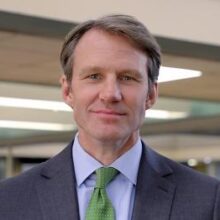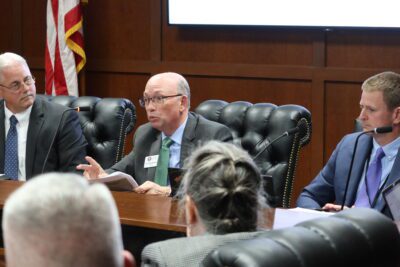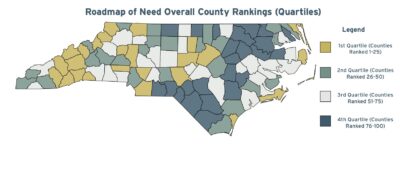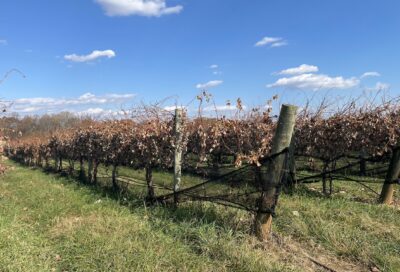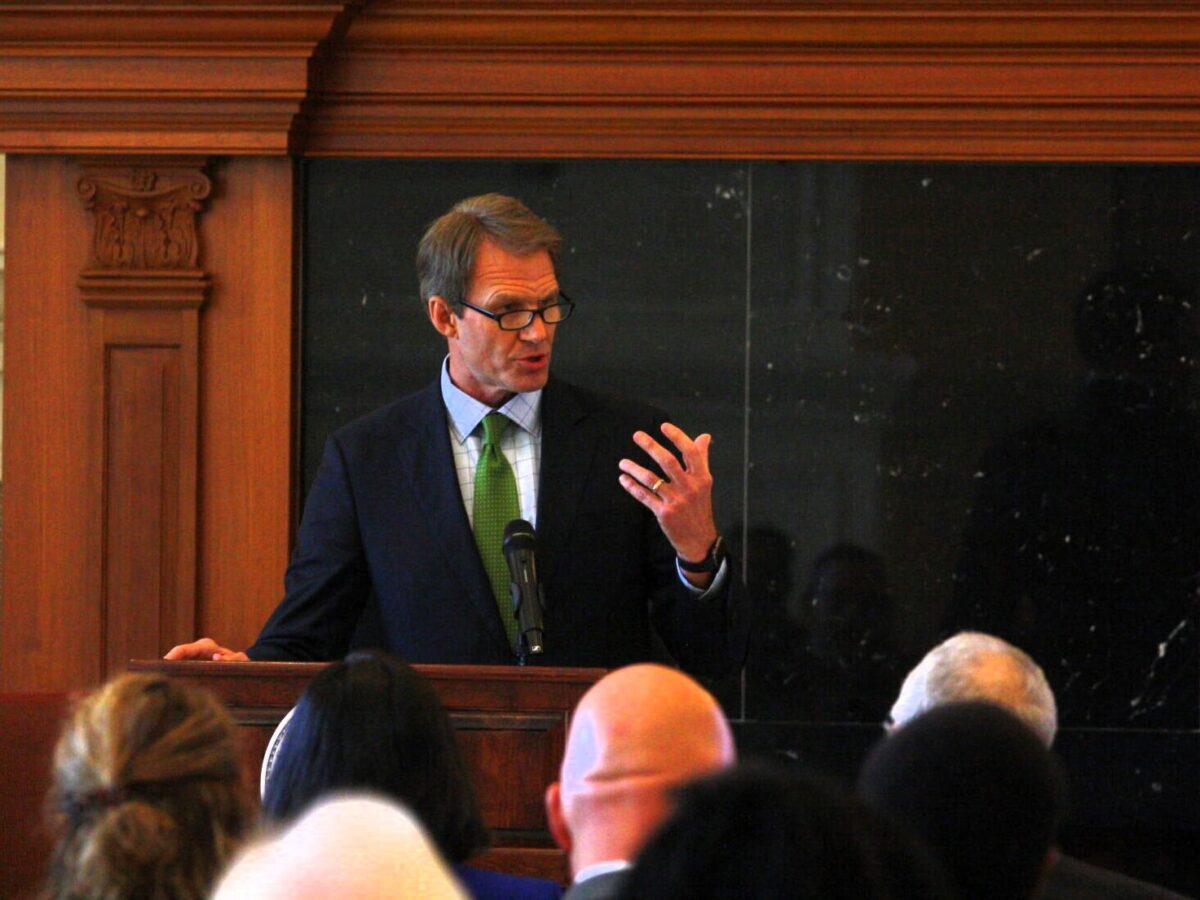

Editor’s Note: The following is a response to the 2023 Dallas Herring Lecture by Falecia Williams, delivered on Nov. 14, from J.B. Buxton, president of Durham Technical Community College.
Thank you, Dr. Williams, for your commitment to our field, the students who come to us, and the communities we serve. Thank you for this call to action today. More on that in a moment.
Thank you in advance to President Shelley White for your remarks. I’ve had a sneak peek and want to express my appreciation for your leadership and the college’s service to the people of Haywood County.
Thank you to the Belk Center for this invitation and NC State University for your support and investment in the Belk Center — your land grant leadership is critical to North Carolina.
Dr. Williams’s challenge
Our state has one of this country’s great mottos: Esse Quam Videri: To Be Rather Than to Seem.
As an educator, I have always loved this motto because it speaks directly to our history in public education: we created the nation’s first public university at the close of the 18th century; in the 1930s we were the only state to keep the schoolhouse doors open throughout the Great Depression; we created one of the nation’s most comprehensive community college systems in the 1960s; in the late 1990s we dared to become First in America in public education; and in the opening decade of the 21st century we built the greatest statewide system of early college high schools in America.
As North Carolinians, educational leadership and innovation is our birthright. Since 1793, we have prized being over seeming in the pursuit of educational excellence.
As a North Carolinian, listening to Dr. Williams I hear an implicit call to assess how well our community colleges live up to our state motto. She has provided a clear-eyed challenge to be not just agents of change, but continuous change institutions – committed to a spirit of transformation; a willingness to set big goals and make course corrections, a dare to be extraordinary.
Our community college DNA
In many ways, this is a role we have long known. We are the original transformation institution, the original equity institution: called upon in the 1960s to help manage the transition from tobacco, furniture, and textiles; to create opportunities no matter educational background or birthright; and to build bridges to K-12 and universities; workforce and community organizations; agencies and employers.
We are the institution committed to talent development, not talent identification. We take pride — to quote our colleague President Ralls — not in the SATs or GPAs of our incoming classes, but in the openness of our doors and — to paraphrase Dr. Herring — in our ability to support people as far as they want to go.
As community colleges we are celebrated for our connectivity, nimbleness, and the impact we can have on people from all walks of life. The twinned nature of our ability to shift to address the needs of our students and employers and our firm anchor in our local communities is the double helix of our genetic makeup that creates impact. It is in our historical DNA.
But that is where we have been.
The challenge I hear Dr. Williams leveling is to commit to continually ask ourselves whether we are living up to that genetic inheritance. To make an unbiased and unabashed commitment to interrogate the mythology of our impact — and in doing so, identify where we measure up and where we don’t. To be rather than to seem.
Accepting the challenge: A framework for introspection
Dr. Williams has provided us with the decisions she and Prince George’s are making about where they focus, the goals they set, what they value, and how they are organized to drive impact. For North Carolina’s urban colleges — each of which is experiencing significant shifts in demographics, industries, and the nature of work — what is our version of that story?
We serve student bodies that are diverse and diversifying. We have dozens of languages and universities in our backyards. Companies like Apple, Toyota, Wolfspeed, Boom and GE Aerospace, ABB, Novo Nordisk, and our health care systems are creating pathways to good jobs and new markets to serve in health care, life sciences, IT, advanced manufacturing, clean tech, EV batteries, and logistics — and not just one or two but all of them in our service areas. We are also at the top of lists you don’t want to lead: places with the least economic mobility and largest wealth gaps.
Given these realities and the choices at hand, where do we train our focus? How should we set a strategy to develop all our talent, drive urban economies that benefit the whole state, and deploy our institutions to solve local challenges?
I want to suggest four questions as a framework to assess how well positioned we are for ongoing transformation and impact — a kind of compass to help determine direction.
First, do we find the community in our colleges?
We often ask whether our student body reflects our community — and rightly so. Equally important: do our faculty and staff and administrators? What perspective do our campus leaders bring? At Durham Tech, when we looked at our performance gaps, we focused on recruiting and growing more people of color into our leadership roles — and specifically men of color — because the lived experience and perspectives of your leadership team makes a major impact on the focus of your change agenda.
Second, do we inspect what our communities expect?
We are expected to be gateways to great universities, pathways to prosperous careers, institutions with local impact. Do we as colleges inspect transparently our progress toward those ambitions? When we looked at our data, we were not satisfied by the median wage of Durham Tech enrollees 10 years later and the percentage of individuals not earning more than a high school graduate or moving up the wage ladder. That led us to two major goals: a 60% completion goal and an 80% job placement goal with at least median wages in-field. We want to ensure that Durham Tech not only helps you cross the finish line but to enter careers that bring stability, mobility, and build generational wealth — and use those success measures to anchor the choices we make about people, programs, and partners.
Third, where do we need to make more of an impact?
The reality of urban North Carolina colleges is we have the luxury to decide which pathways and jobs we want to focus on — a luxury that calls on us to ask some tough questions. Do our programs lead to livable wages? To careers where our graduates can grow? To transfer success? Over the last few years at Durham Tech, we have closed seven degree programs and 30+ certificates because they didn’t align with projected demand or led to less than livable wages — and created the room to add new ones or scale existing ones that meet those tests.
What we haven’t taken up — but know we must — is addressing how well aligned our overall and subgroup enrollment is with high-value pathways in our backyards — think STEM, baccalaureate transfer, technicians. Are we advising and positioning everyone for opportunity and options? As one example, thanks to our county commissioners, corporate partner Novo Nordisk, and the nonprofit organization Made in Durham, we are not just making a big bet in the life sciences, but big investments in ensuring widespread access to this sector.
Fourth, where are our peer colleges indispensable to our own success?
At Durham Tech, I can throw a rock and hit Wake Tech, Piedmont, Vance-Granville, Johnston, Alamance, and Central Carolina. In a labor market where companies are looking at 20+ counties for talent, employers, and students could care less about the county line. We simply can’t do our job without working with our peers to deliver results. Durham Tech launched RTP Bio with Wake Tech to pool resources and commit to a shared approach on community awareness, customized training, curriculum and faculty development, apprenticeships, program offerings, and student scholarships. Many colleges are developing similar strategies. Rather than being endangered by our neighboring institutions, where is our success enhanced by and dependent on them — and how do make this the rule not the exception?
Living into our inheritance
Our students work hard to get to us, stay enrolled with us, finish with us. They may not walk 130 miles like Hinton James did to become the first postsecondary student in North Carolina, but they often manage jobs, families, and other personal challenges to join and persist at our colleges with the goal of being able to have more, to do more, to be more.
Our cities and counties look to us to deliver talent, attract and grow companies, and step in on key community and quality of life priorities.
The four questions I suggest we continually ask ourselves — Is our community truly reflected in our college? Do we inspect what we expect? Where do we need to make more of an impact? And, where are our peers indispensable to our success? — are meant to inspire introspection, not proclaim prescriptions. They are intended to answer Dr Williams’s call to lead with courage and transformational power, and to be equal to the determination of our students and the needs of our communities.
It is our challenge to ensure the romance of the community college is in fact the reality. Because in the end — after all the speechifying — what speaks last and loudest is not what we say we are, but what the success of our students and communities reveals us to be. And defines if we are living into the institutional inheritance bequeathed to us as our communities’ colleges. Esse quam videri.
